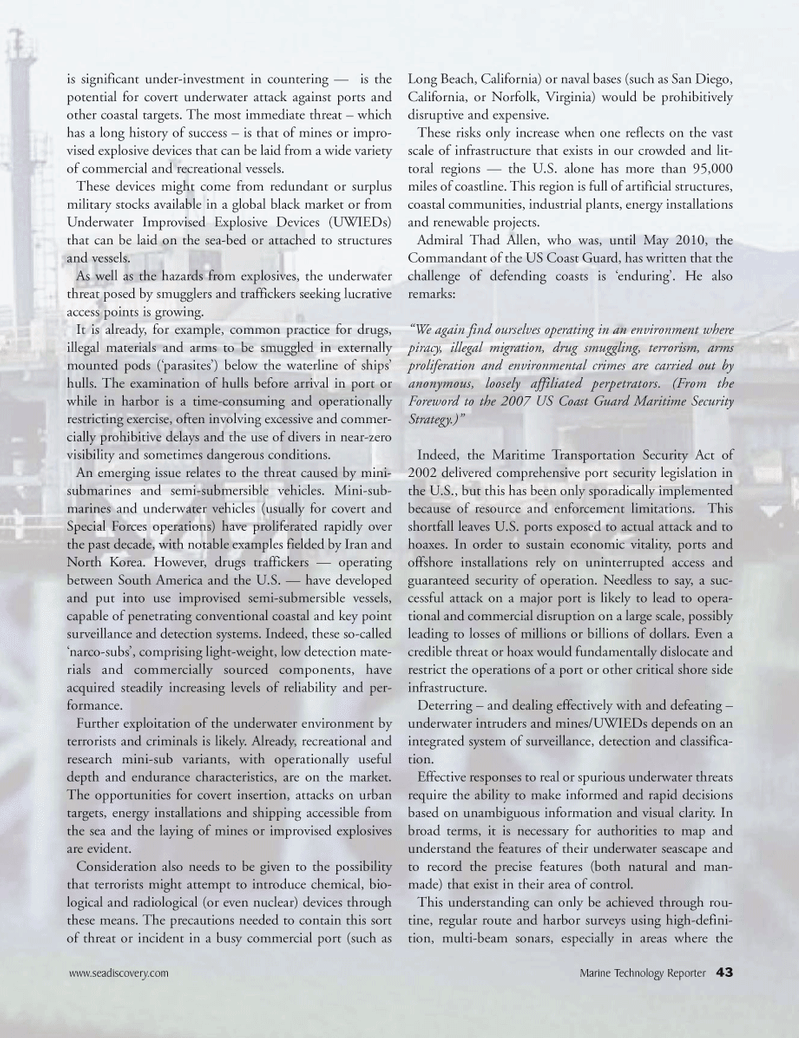
Page 43: of Marine Technology Magazine (November 2010)
Fresh Water Monitoring and Sensors(lakes, rivers, reservoirs)
Read this page in Pdf, Flash or Html5 edition of November 2010 Marine Technology Magazine
www.seadiscovery.com Marine Technology Reporter 43 is significant under-investment in countering — is the potential for covert underwater attack against ports and other coastal targets. The most immediate threat – which has a long history of success – is that of mines or impro- vised explosive devices that can be laid from a wide variety of commercial and recreational vessels.
These devices might come from redundant or surplus military stocks available in a global black market or from
Underwater Improvised Explosive Devices (UWIEDs) that can be laid on the sea-bed or attached to structures and vessels.
As well as the hazards from explosives, the underwater threat posed by smugglers and traffickers seeking lucrative access points is growing.
It is already, for example, common practice for drugs, illegal materials and arms to be smuggled in externally mounted pods (‘parasites’) below the waterline of ships’ hulls. The examination of hulls before arrival in port or while in harbor is a time-consuming and operationally restricting exercise, often involving excessive and commer- cially prohibitive delays and the use of divers in near-zero visibility and sometimes dangerous conditions.
An emerging issue relates to the threat caused by mini- submarines and semi-submersible vehicles. Mini-sub- marines and underwater vehicles (usually for covert and
Special Forces operations) have proliferated rapidly over the past decade, with notable examples fielded by Iran and
North Korea. However, drugs traffickers — operating between South America and the U.S. — have developed and put into use improvised semi-submersible vessels, capable of penetrating conventional coastal and key point surveillance and detection systems. Indeed, these so-called ‘narco-subs’, comprising light-weight, low detection mate- rials and commercially sourced components, have acquired steadily increasing levels of reliability and per- formance.
Further exploitation of the underwater environment by terrorists and criminals is likely. Already, recreational and research mini-sub variants, with operationally useful depth and endurance characteristics, are on the market.
The opportunities for covert insertion, attacks on urban targets, energy installations and shipping accessible from the sea and the laying of mines or improvised explosives are evident.
Consideration also needs to be given to the possibility that terrorists might attempt to introduce chemical, bio- logical and radiological (or even nuclear) devices through these means. The precautions needed to contain this sort of threat or incident in a busy commercial port (such as
Long Beach, California) or naval bases (such as San Diego,
California, or Norfolk, Virginia) would be prohibitively disruptive and expensive.
These risks only increase when one reflects on the vast scale of infrastructure that exists in our crowded and lit- toral regions — the U.S. alone has more than 95,000 miles of coastline. This region is full of artificial structures, coastal communities, industrial plants, energy installations and renewable projects.
Admiral Thad Allen, who was, until May 2010, the
Commandant of the US Coast Guard, has written that the challenge of defending coasts is ‘enduring’. He also remarks: “We again find ourselves operating in an environment where piracy, illegal migration, drug smuggling, terrorism, arms proliferation and environmental crimes are carried out by anonymous, loosely affiliated perpetrators. (From the
Foreword to the 2007 US Coast Guard Maritime Security
Strategy.)”
Indeed, the Maritime Transportation Security Act of 2002 delivered comprehensive port security legislation in the U.S., but this has been only sporadically implemented because of resource and enforcement limitations. This shortfall leaves U.S. ports exposed to actual attack and to hoaxes. In order to sustain economic vitality, ports and offshore installations rely on uninterrupted access and guaranteed security of operation. Needless to say, a suc- cessful attack on a major port is likely to lead to opera- tional and commercial disruption on a large scale, possibly leading to losses of millions or billions of dollars. Even a credible threat or hoax would fundamentally dislocate and restrict the operations of a port or other critical shore side infrastructure.
Deterring – and dealing effectively with and defeating – underwater intruders and mines/UWIEDs depends on an integrated system of surveillance, detection and classifica- tion.
Effective responses to real or spurious underwater threats require the ability to make informed and rapid decisions based on unambiguous information and visual clarity. In broad terms, it is necessary for authorities to map and understand the features of their underwater seascape and to record the precise features (both natural and man- made) that exist in their area of control.
This understanding can only be achieved through rou- tine, regular route and harbor surveys using high-defini- tion, multi-beam sonars, especially in areas where the

 42
42

 44
44
